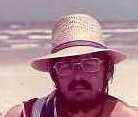
The year was 1972. British rockers The Moody Blues were coming to town and the show was a sellout. But I wasn't going to be there. My colleague, Jerry Zenick, was scheduled to attend and write the review.
But something happened that forced Jerry to cancel out at the last minute. That's when he asked me to go in his place.
The Moodies were among my favorites and I was delighted to accept.
As my wife Pam and I settled in our seats (dodging the ever-present flying Frisbees zinging around the vast confines of the TCCC (Tarrant County Convention Center), the lights dimmed for the warm-up act, a duo known as Fat City.
I discovered Fat City was a husband and wife team, Bill Danoff and Taffy Nivert, whose main claim to fame was co-writing the iconic pop ballad that propelled one-time Fort Worth resident John Denver (aka John Deutschendorf, Jr) to stardom: "Take Me Home, Country Roads."
Then, just as now, warm-up acts had a tough job. Everyone was there to see the main event. Warm-up acts were generally viewed as a conspiracy to 1) increase business at the concession stands, 2) allow the headliners more time to lounge (or whatever) or 3) accomodate late-arriving concert-goers held up by traffic (or whatever).
In this case, Fat City's focus on ballads and folk was in direct juxaposition to the Moodies' mix of pulsating rock and psychedelic pop.
As their set ended and the house lights came up, the promoter we worked with at Concerts West, the company that handled most of the big tours at that time, came over to my seat.
"Where's Jerry?" she asked. I explained he had to cancel and I was in his place. That's when I found out an interview had been set up with Fat City back stage and they were waiting. A little detail Jerry had left out.
So off we went to their back stage dressing room to conduct an interview I was totally unprepared to do.
Looking back, Bill and Taffy had to be among my first interviews as a music writer. And as it turned out, one of the most pleasant.
As we sat down to talk, my initial nervousness quickly dissipated. Bill and Taffy were a delight: Funny, down-to-earth, smart. They had turned stints at the famed Washington D.C. (their home base) Cellar Door into touring with some of music's biggest acts and were thoroughly enjoying the ride.
That chance encounter became the basis for a friendship that would span the next ten years.
A couple of factoids from a half-dozen interviews over that time:
-- Taffy's real name is Mary Catherine. But when her brother tried to pronounce it, it came out "Taffy." The name stuck.
-- Bill, who used to work the light and sound equipment at the Cellar Door, has a BA in Chinese from Georgetown University.
-- When they met in the late Sixties, Taffy was working as a typist for the AFL-CIO. When a vacany came up in Bill's band, Taffy joined as a singer. That ended her secretarial career.
-- Their first album as Fat City was "Reincarnation," released by Paramount Records in 1970.
-- They met an up and coming folksinger named John Denver at the Cellar Door in 1970. The three of them polished up "Take Me Home, Country Roads." That's Bill and Taffy signing backup on it.
In the years following the Moody Blues show, Bill and Taffy returned several times to the Dallas/Fort Worth area, including a stop at a Dallas club called Mother Blues in 1974.
Then, in 1976, the duo became a foursome as longtime friends Margo Chapman and Jon Carroll joined to form the Starland Vocal Band. Bill penned a new song you may have heard --"Afternoon Delight," and suddenly, as the lyric from it goes, their career became "a skyrocket in flight."
Starland became one of the first groups signed to John Denver's Windsong label. They also toured with Denver, which included a stop in Dallas.
In the years that followed, Bill and Taffy would go their separate ways. But I'll always look back fondly on the friendship that grew from the interview I wasn't supposed to be at.

